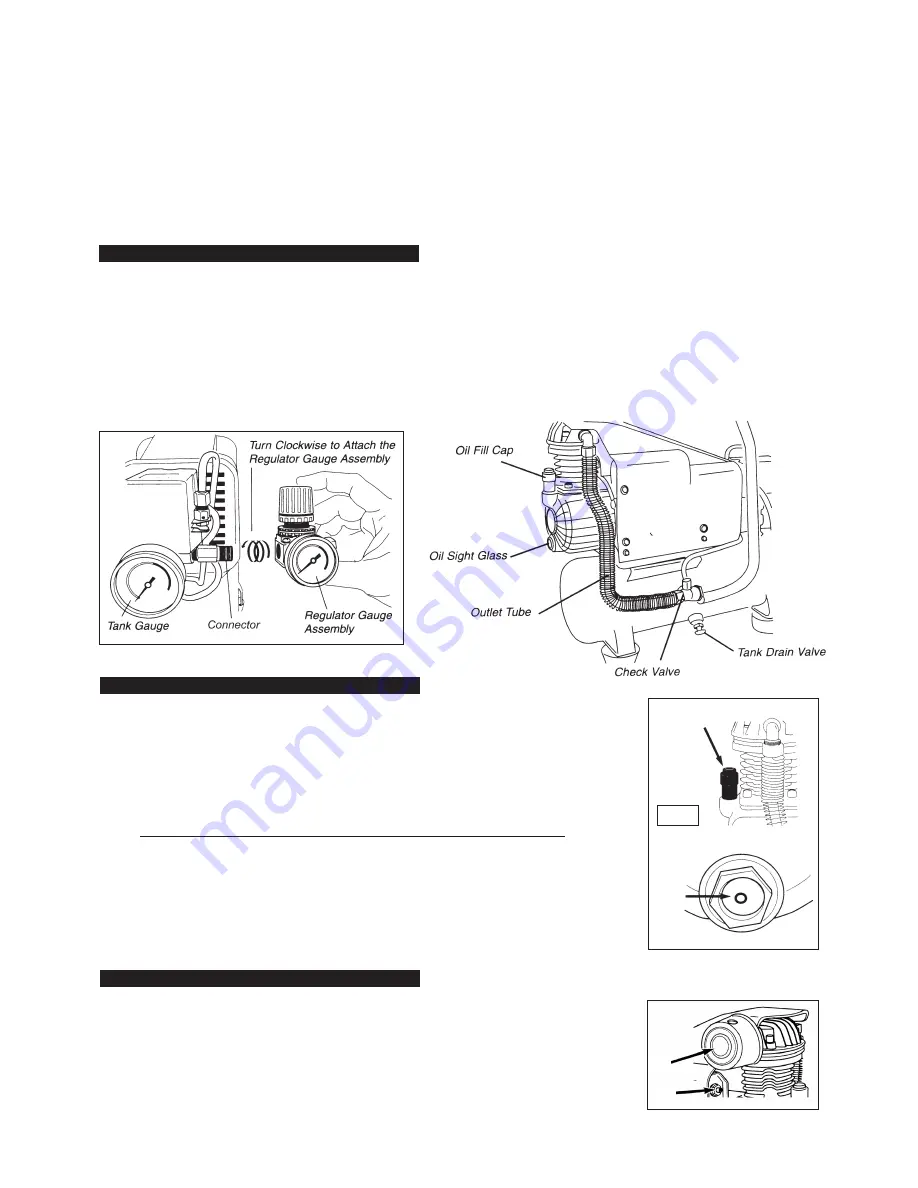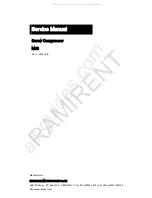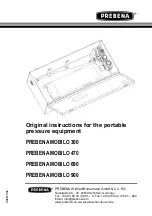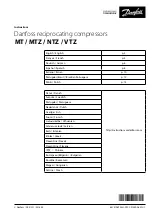
2. iNtrODUCtiON & sPeCiFiCAtiON
compact and portable, this compressor is suitable for use with the sealey range of air nailers and air brushes and is fitted with twin gauges to
display both the tank pressure and the working pressure. fitted with 4 anti-vibration suction feet for added stability when in use. complies fully
with current european standards.
3. PrePArAtiON & AsseMBlY
4. tOOl seleCtiON
WArNiNG! the compressor is supplied without any lubricating oil in the pump - see para. 3.4.
3.1.
remove compressor from packaging and inspect for any shortages or damage. If anything is
found to be missing or damaged contact your supplier.
3.2.
confirm that the mains voltage corresponds with the voltage shown on the compressor data plate.
3.3.
the compressor should be installed on a flat surface, or one that does not exceed 15
°
either
transversely or longitudinally, and should be in a position that allows good air circulation around
the unit.
3.4.
iMPOrtANt! remove the oil filler/breather from the pump (fig.2-A) and add the oil provided
until the level is up to the centre of sight glass (fig. 2-B). replace the filler/breather.
DO NOt AtteMPt tO rUN tHe COMPressOr UNtil tHis HAs BeeN DONe.
3.5
ensure that the air vent in the oil filler/breather is free from debris. if the air vent is
blocked, pressure can build up in the crankcase causing damage to the compressor and
possible personal injury.
3.6.
screw air filter (fig.3.c) into inlet port.
3.7
regulator assembly.
( see fig.1-a ) remove any packing material from the connector attached
to the pressure switch. check that the connector thread has a factory applied sealant to prevent
leaks. thread the regulator assembly onto the connector making sure that it is properly aligned to
avoid cross threading. the assembly should rotate approximately 6 to 7 revolutions. the two
gauges should be facing in the same direction. do not overtighten.
iMPOrtANt
take care when selecting tools for use with the compressor. Air tool manufacturers
normally express the volume of air required to operate a tool in cubic feet per minute (cfm).
this refers to free air delivered by the compressor (‘air out’) which varies according to the
pressure setting. Do not confuse this with the compressor displacement which is the air
taken in by the compressor (‘air in’). ‘Air out’ is always less than ‘air in’ - due to losses
within the compressor - and so it is important that, before choosing equipment, you study
the ‘Free Air Delivery’ figures shown in the specification Chart above.
fig. 1-A
fig. 1
fig. 2
7
DO NOt
use this product to perform a task for which it is not designed.
7
DO NOt
deface the certification plate attached to the compressor tank.
7
DO NOt
cover the compressor or restrict air flow around the machine whilst operating.
DANGER! DO NOT direct the output jet of air towards people or animals.
7
DO NOt
operate the compressor without an air filter.
7
DO NOt
allow anyone to operate the compressor unless they have received full instructions.
WArNiNG!
The air tank is a pressure vessel and the following safety measures apply:
7
DO NOT tamper with the safety valve and DO NOT modify or alter the tank in any way and DO NOT strap anything to the tank.
7
DO NOT subject the tank to impact, vibration or to heat and DO NOT allow contact with abrasive or corrosive materials.
3
DO drain condensation from tank daily and inspect inside walls for corrosion every three months. Have a detailed tank
inspection carried out annually.
The tank shell must not fall below the certified thickness at any point..
WArNiNG!
If an electrical fuse blows, ensure that it is replaced with one of identical type and rating.
3
When not in use, disconnect from the mains, vent the tank and store the compressor in a safe, dry, childproof location.
fig. 3
MODel
. . . . . . . . . . . . . . . . . . . . . . . . . . . . . . . . . . . . . . . .
sA2306
Motor output
. . . . . . . . . . . . . . . . . . . . . . . . . . . . . . . . . . . . . . .1hp
Voltage/phase
. . . . . . . . . . . . . . . . . . . . . . . . . . . . . . . . . . . 230V/1
Current
. . . . . . . . . . . . . . . . . . . . . . . . . . . . . . . . . . . . . . . . . . . 3.5a
Pump type
. . . . . . . . . . . . . . . . . . . . . . . . . . . . . . . . single cylinder
Piston displacement
. . . . . . . . . . . . . . . . . . . . . . . . . . . . . . 4.5cfm
Free air delivery
. . . . . . . . . . . . . . . . . . . . . . . . . . . . . . . . . . . .4cfm
tank capacity
. . . . . . . . . . . . . . . . . . . . . . . . . . . . . . . . . . . . . . . 6ltr
Max pressure
. . . . . . . . . . . . . . . . . . . . . . . . . . . . . . . 115psi / 8bar
Noise level
. . . . . . . . . . . . . . . . . . . . . . . . . . . . . . . . . . . . . .78dB.a
Weight
. . . . . . . . . . . . . . . . . . . . . . . . . . . . . . . . . . . . . . . . . 15.85kg
Dimensions
- length x width x height . . . . . . .460 x 175 x 420mm
A
C
D
B
sa2306 - 2 - 010208






















